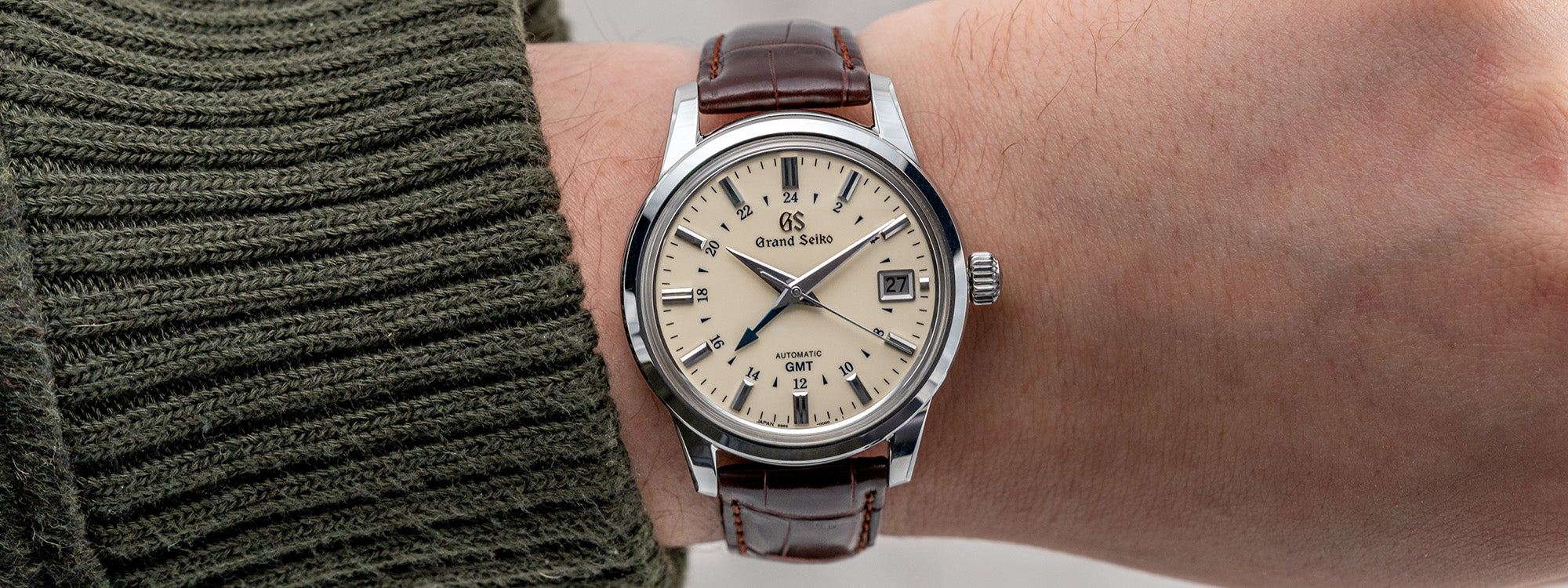The GMT market has changed dramatically in the past seven years. I use that number specifically, because it takes us to 2018, when Tudor brought attainable traveller GMT (independent hour hand functionality) to market in a splashy way. Since then we have seen brands like Longines and Mido continue the work by delivering more options at even better price points. From a general “caller GMT” standpoint, Seiko has knocked it out of the park with models like those within the SSK range. We are living in a GMT moment with more options than ever.
But if you took things back just one more year, to 2017, you could argue that it was the year Japan’s Grand Seiko made a mic-dropping value statement by way of the SBGM221, a traveller GMT in a dressier package with elite functionality while delivering value that far outpaces its price point. In 2025, that value proposition has not changed at all.
Background:

The DNA of the SBGM221 looks back to the early roots of Grand Seiko in the 1960s to inform its design, but from a modern standpoint more directly can look to the SBGM021 released around 2010. That year is significant because it was the first year the brand arrived in the U.S. market. Aesthetically, the SBGM021 is an illustration of the older style of co-branded Seiko/Grand Seiko fare. Fast forward to 2017, and the watch reaches its completed form. But the 021, with its ivory dial, and general – and honestly quite original – GMT layout is established. You can see the direct connection between these two watches.
In the runup to the SBGM221, and even today – in the face of a resurgence of GMT watches on the market – Grand Seiko has shown a special penchant for the creation of models utilizing Hi-Beat, Spring Drive and (pertinent to today’s discussion), the 4Hz 9S66-powered range of watches. Unlike competitors in the market from a Longines to a Tudor, Grand Seiko has consistently shown no allegiance to a specific form when it comes to the GMT. Those aforementioned brands have seen fit to house the complication in more sporty fare. Grand Seiko certainly has the playbook, but when it comes to the SBGM221, we are looking at a far more refined affair.
Overview:
Movement:

Let’s begin with what would typically be one of the latter points in a review—the movement. It’s an element that often flies under the radar but plays a central role in what makes this watch such a compelling package. While it may not get the same spotlight as the design or finishing, the caliber housed inside this model is a bona fide overachiever. As one of the brand’s more accessible mechanical offerings, the inclusion of the 9S66 automatic GMT movement adds a significant degree of value to the overall proposition… dare we say (okay, we will) a value proposition.
Though not a new development, the 9S66 has been a reliable workhorse in Grand Seiko’s lineup for more than a decade. Even today we would argue it is one of the best GMT movements in its price segment. At its core, this is a “true” GMT — or traveller’s GMT—caliber, meaning (as we indicated at the top) that the local hour hand is independently adjustable in one-hour increments, both forward and backward, without stopping the movement. It beats at a standard rate of 28,800 vibrations per hour (4Hz), and boasts a 72-hour (three-day) power reserve.

In terms of accuracy, the 9S66 performs remarkably well. Grand Seiko regulates the caliber to a quoted standard of -3 to +5 seconds per day, which surpasses COSC’s chronometer requirements of -4 to +6. The particular example we reviewed ran even tighter, averaging between -2 and +3 seconds per day across five positions.
The GS Caliber 9S66 gets a decided benefit from Grand Seiko’s advanced MEMS (Micro-Electro-Mechanical Systems) manufacturing technology. This highly precise fabrication method is used to produce extremely lightweight and efficient components, most notably seen in the skeletonized escapement parts. The escape wheel, for instance, features intricately cut teeth designed with tiny recessed oil pockets, improving lubricant retention and enhancing long-term durability where friction is most intense.

The movement itself is displayed through a sapphire exhibition caseback, with finishing that includes striped decoration across the bridges and the partially openworked rotor, polished screw heads, visible synthetic ruby jewels, and cleanly engraved lettering.
In terms of functionality, the 9S66 is intuitive and satisfying to operate. The crown's first position winds the movement, while the second position enables independent adjustment of the local hour hand — linked to the date wheel for seamless travel-time corrections. Pulling the crown to its final position stops the seconds hand for precise time-setting and allows you to adjust the time in full. Now the only thing worth noting is that the exclusion of a traditional quick-set date does make changing the date a less-than-quick process, as the hour hand needs to make 24-hour revolutions before the date changes. This is only really an issue when you pick up your watch after it has not been used for some time and you're many days apart from what is showing on the date wheel.
Dial:

The dial sits beneath a highly domed sapphire crystal — treated with an anti-reflective coating on its underside for optimal legibility. Overall, it presents as a masterclass in subtlety, symmetry, and restraint – even though it gives the user a lot of information in a confined space. The focal point is its rich ivory surface, which has become one of the defining traits of this reference and a key reason it has attained iconic status.
Beginning at the outer perimeter, a finely printed minute track in crisp black ink encircles the dial, with the markings discreetly omitted at each hour position to allow space for the finely finished hour indices. Each index is individually faceted, mirror polished, and applied by hand — an attention to detail that elevates the watch's perceived value and visual presence.

Stepping in slightly, the inner 24-hour scale is laid out in dark printing, with the even-numbered hours marked numerically and the odd hours denoted by small, sharply defined arrowhead markers. This acts in perfect coordination with the blued GMT hand, which stretches across the dial to track a second time zone with precision.
Now is as good a time as any to address a common Grand Seiko-ism: the nickname. You know the Snowflake, you know the Shunbun. Well, it has come to our attention that steam is really picking up on the SBGM221’s claim to the Shohei name – which, much like the Rolex Steve McQueen, emerged from legend. It would appear that GQ may have inadvertently mis-spotted L.A. Dodgers slugger and ace Shohei Ohtani wearing the SBGM221 when he signed his mammoth deal with the club. No matter, we have it on good authority that he does own and wear the watch often. As if by fate, the blue GMT hand gives it a real Dodgers feel — and even the ivory dial matches some of the seats at Dodgers Stadium. So, henceforth, we shall refer to this watch as the Shohei. But back to the dial design.

At the center of the dial, a pair of highly polished dauphine-style hands handle the local hour and minute display. These hands are sculpted with a central flat plane bordered by sharply beveled edges, allowing them to catch light dynamically from virtually any angle. Accompanying them is a long, needle-like central seconds hand and the tempered blue GMT hand — an aesthetic and functional highlight that adds both color contrast and practical utility.
Just below the 12 o’clock position sits the polished, applied Grand Seiko “GS” emblem, while the brand’s full wordmark is printed immediately beneath it. At 6 o’clock, cleanly printed “Automatic” and “GMT” text offer a balanced visual counterweight. And completing the layout, a beveled and faceted date window at 3 o’clock reveals a simple white date disk set just below the dial surface, maintaining the overall tonal harmony and understated elegance.
Wear & Case:

A significant part of the Shohei’s broad appeal lies in how it wears on the wrist. With a diameter of 39.5mm, a lug-to-lug distance of 46.9mm, and a thickness of 13.7mm, the SBGM221 sits comfortably within that sweet spot of proportions that strikes a balance between classic and contemporary. On the wrist, the watch wears true to its dimensions; if anything, it leans ever so slightly smaller thanks to its compact lug profile and curved case flanks. While the thickness is modest for a mechanical GMT — especially one featuring a true traveler’s complication and a prominent box-shaped crystal — it may still be the one measurement that could give more size-sensitive buyers pause. That said, it remains thinner than many competitors in the same category, and is imperceptible when worn (and, honestly, when not worn).
Set between 19mm lugs, the SBGM221 comes equipped with a high-quality brown alligator leather strap featuring a glossy finish on top and a supple calfskin lining underneath for added comfort. While initially a bit rigid out of the box, the strap will break in over time. That being said, the Shohei is a strap monster and is a strong candidate for strap changes — think textured calf, suedes, or even canvas options — to make the most of its versatile aesthetic personality. The strap tapers to a 16mm width at the clasp, which features a folding deployant mechanism with a traditional pin buckle-style closure signed with the Grand Seiko logo. The clasp ensures secure fastening while maintaining a classic appearance in line with the watch's overall design language.

The case design is where the watch really shows the Grand Seiko difference. Rather than going for an angular or aggressively sporty look, the SBGM221 opts for softer, more organic curves. The entire stainless-steel case showcases Grand Seiko’s famed Zaratsu polishing — a meticulous, distortion-free mirror finishing technique performed by skilled craftspeople at the brand’s Shinshu Studio, a technique that is often referred to as black polishing. This polishing adds a dynamic interplay of light and shadow across the rounded surfaces, enhancing the case’s visual fluidity and refinement.
At 6mm in diameter, the signed crown features prominent ridging for easy grip, making both winding and setting operations a tactile pleasure. Paired with a screw-down caseback, the watch achieves a water resistance rating of 30 meters. Yes, 30 meters for a GMT watch, which again brings back to top of mind the notion that this is a dress GMT more so than anything sporty.
Framing the dial is a polished bezel that gently slopes into the domed sapphire crystal, acting as a bridge between the case and the glass. The curvature of the lugs, paired with the overall compact profile, rounds out the case architecture.
Pros & Cons:

From a pros and cons perspective, we can start with the pros, the first of which has to be the price in relation to the overall package, namely the movement, and the quality of finishing. It is almost preposterous to think that this watch’s price still begins with the number 4. At $4,900 at the time of writing, there is arguably no better “pro” than what you are getting for your dollar here.
The dial brings a dressy take on a travel complication but also has cemented itself as an icon for Grand Seiko, in the same way that Rolex has its bezel format solidified in horological iconography. The polishing on the hands and markers (and case), showcase the brand’s sheer mastery in the craft.

Of course with any pros, come some cons. And as much as we love the polished hands and markers, it also comes with the caveat that this watch has no lume to speak of. Now if you ask anyone who owns a Grand Seiko with no lume, they will boast that the polish is so finely done that you can read a watch like this in the dark just from the way it shines. I cannot really argue with that; however, this does not compensate for a lack of lume.
Staying on the idea that this is more a dress-watch GMT than a sporty one, the biggest con has to be the fact that the watch only boasts 30 meters of water resistance – a rating Grand Seiko itself refers to as “splash proof.” Not the most reassuring, but as long as you understand that up front, there is still so much to enjoy about the SBG221 that far outweighs its water resistance.
Final Thoughts:
In recent years, Grand Seiko has been anything but quiet. The brand has taken an increasingly prolific approach to releasing new models — season after season, year after year. For collectors like us, this can be thrilling. There’s always something new on the horizon, and the sheer pace of releases keeps the community engaged and speculating about what’s next. But this excitement also comes with a bit of a challenge: navigating the growing catalog. With so many references spanning different movements, case shapes, dial finishes, and aesthetic directions, figuring out where to begin can feel like being dropped into a maze with no clear path.
Of course, there are the usual suspects that tend to come up first. The SBGA211 "Snowflake" is practically a rite of passage for many. The Four Seasons collection offers a poetic take on Japan’s natural beauty. There are the sharply executed 9F quartz GMTs, and then the quietly elegant SBGW hand-winding models powered by the 9S64. And let’s not forget standouts like the Omiwatari, with its textured ice-dial artistry. All of these are strong contenders depending on your taste and priorities.

Yet, quietly but confidently, this model—the SBGM221, aka the Shohei—deserves to be right there at the top of the conversation. At first glance, it might not check every box: it doesn’t feature a Spring Drive, it’s not powered by a high-beat caliber, the water resistance is limited to 30 meters, and its 13.7mm thickness may raise eyebrows among dress-watch purists. Its dial, though beautifully done, doesn’t immediately command attention like some of Grand Seiko’s more experimental designs. And yet, despite these seeming compromises, or perhaps because of them, it represents the brand in a way that’s honest, refined, and deeply rewarding.
The SBGM221 distills many of the core attributes that define Grand Seiko: the purity and legibility of the dial layout, the thoughtful proportions and wearability, and the technically outstanding and masterfully finished in-house movement. It’s not a watch that shouts; it invites you to look closer. And with every glance, you discover a new reason to appreciate it.
For under $5,000, the Shohei has stood as one of the most complete and compelling representations of what Grand Seiko does best. Even after several years on the market, and amidst a flood of new releases, it remains an essential reference within the brand’s catalog – an icon – and as perfect an entry point as there can be for those beginning their journey into the world of Grand Seiko.
Grand Seiko SBGM221
Price: $4,900
Case Diameter: 39.5mm
Thickness: 13.7mm
Lug-to-Lug: 46.9mm
Lug Width: 19mm
Water Resistance: 30m
Movement: Auto GS 9S66
Crystal: Sapphire






















































0 Comments